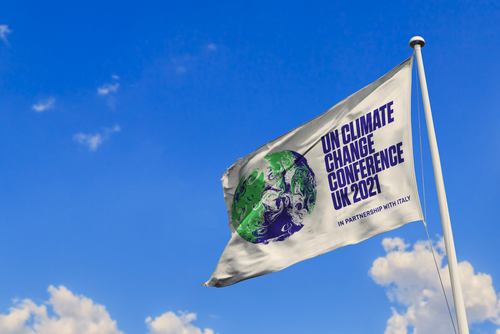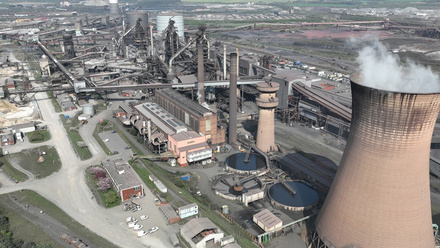A personal insight into COP26
Richard M Oblath PhD CEng FIMMM FEI, Chair of IOM3 Energy Transition Group reflects on the first week of COP26 from Glasgow.

During my virtual attendance at various COP26 meetings (some hybrid, some public and some private mostly under the Chatham House rule) in the first week of the climate talks I have focused on:
- the commitments made on greenhouse gas (GHG) reductions and the related temperature rise projections versus the maximum 1.5C target
- commitments on rapid reductions of key GHG emission sources, for example coal and methane
- financing the global decarbonisation
- progress on implementing a global, transparent carbon pricing and trading system per the aspiration outlined in COP21 (Paris) Article 6
Reducing emissions
Overall commitments made on GHG reductions have likely reduced the projected temperature rise by 2100 to 1.9C versus the over 3C after COP21 in Paris in 2015, 2.7C in pre-COP26 analysis by the United Nations (UN). One of the big impacts was India committing to net zero by 2070. This is the good news, but the bad news is that these commitments even if all implemented do not achieve under 1.5C and it is likely 1.5C will be reached before mid-century (the world is already at 1.1C).
In addition, China did not attend at leadership level although a senior delegation is present and did not make any formal changes to their goals previously announced of net zero by 2060 and GHG peak emissions by 2030. Further bad news is that very few countries have translated their commitments into legislation as the UK did in 2019. The largest risks due to their size of current emissions are a) the USA where promises and even executive orders can be reversed by a new President in 2024 and legislation and funding by Congress which has not yet been achieved is required to make these more likely and b) the EU which despite a lot of rhetoric about 55% reduction in GHGs by 2030 still needs Parliament endorsement and approval by each of the 27 members countries.
Targets for ending the mining of coal and its use in power generation has advanced somewhat during COP26. The G-20 (including China and Japan) agreed to stop funding non-local coal plants and a dozen countries (including Vietnam, Chile and South Korea) agreed to accelerate the phase out of coal but disappointingly this did not include the US and China. Indonesia asked for more funding to speed up their ending using coal and absurdly Poland claimed they were a developing country and thus should be allowed to delay the phase out from 2030 to 2040. An interesting development was an agreement by the UK and USA plus some other countries to provide US$8.5bln to speed up South Africa’s energy transition including elimination of coal mining and its use in power generation within 10 years. Japan is planning to invest US$100m to transform coal-fired plants into ones that burn ammonia and hydrogen — not only in Japan, but also elsewhere in Asia through a framework called the Asia Energy Transition Initiative. In addition, the Asian Development Bank announced a plan to help Indonesia and the Philippines retire 50% of their coal fleet over the next 10 to 15 years. These multilateral rather than global agreements are a new pathway and may rally the aspiration of many to ‘consign coal to history.’
The other GHG that has been the focus of much debate is methane with more than 100 countries signing the Global Methane Pledge to cut these emissions by at least 30% by 2030 although below the targeted 45% reduction. As methane is 86 times more potent a GHG than CO2 (with a shorter life in the atmosphere) this is an important move to slow the global rise in temperatures. Disappointingly, the pledge was not signed by three major emitters, China, India and Russia.
While public financing is seen to be crucial to unlock much larger private sums, at the summit there were positive signs that private money might be preparing to move on its own. Former Bank of England Governor, Mark Carney, led the formation of the Glasgow Financial Alliance for Net Zero (GFANZ), bringing together asset managers from around the world with US$130 trillion under management to accept the goal of zeroing-out emissions by 2050. The rich nations promise to the developing nations at COP21 in Paris to provide US$100bln per year for help in combating climate change was not met and may not be until 2023 despite increased pledges by Japan, Canada and Italy, formally laggards.
Finance proposals
During Finance Day many emphasised the need for a global carbon price if financing is to be transformational. This would impact all entities needing financing, not just those controlled by some institutional investors. The job of the financial system would then be to amplify the signal sent by carbon prices. A senior member of GFANZ said that, ‘The combination of private funding and a carbon price would be a powerful engine for changing how economies work.’
The negotiations on implementing a global, transparent carbon pricing and trading system per the aspiration outlined in COP21 (Paris) Article 6 have apparently progressed but are still some way from agreement. Brazil, a hold out in Paris, appear to have shown a willingness to compromise. Some very difficult issues still need to be agreed and meetings are taking place around the clock.
Deforestation and a Carbon Border Levy
Lastly, a couple of other matters that caught my attention, one on deforestation and the other on the controversial proposals on carbon border taxes being implemented soon to protect green industries from imports from countries that have not improved their emissions performance.
Unlike previous plans to protect forests, the UK-led one to halt and reverse deforestation was backed by over 100 countries including Brazil, home to Amazon jungle, and Russia, home to the world’s largest expanse of temperate forests. It also came with a US$19 billion commitment from both governments and companies.
The EU president emphasised the bloc’s commitment to a carbon border levy as part of the European plan to attack global warming. Proposed earlier this year, the carbon border adjustment would tax fossil-fuel imports such as steel, aluminium, fertiliser and cement. Stating, ‘We will now introduce, slowly but surely, a carbon border adjustment mechanism that says, ‘If you come with a dirty product to our market, you have to pay a price as if you were in the emissions trading system in the European Union. But we prefer that you keep the money in your economy by putting a price on carbon in your economy.’ This threat appears to have already had an impact as a very senior member of the Russian government disclosed that due to this threat it has in the past few months started planning for the first time the development of a large hydrogen economy (for use within Russia and for exports) and especially improving the emissions from hard to abate sections of their economy, such as steel, aluminium and fertilisers.







